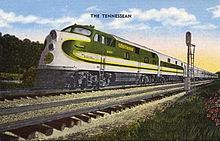Tennessean (train)
 |
|
| Overview | |
|---|---|
| Service type | Inter-city rail |
| First service | May 17, 1941 |
| Last service | March 30, 1968 |
| Former operator(s) | Southern Railway via Norfolk and Western Railway |
| Route | |
| Start | Washington, DC |
| Stops | Alexandria, Virginia, Charlottesville, Virginia, Lynchburg, Virginia, Roanoke, Virginia, Bristol, Tennessee, Johnson City, Tennessee, Greeneville, Tennessee, Morristown, Tennessee, Knoxville, Tennessee, Cleveland, Tennessee, Chattanooga, Tennessee, connecting service available to Nashville, Tennessee via Nashville, Chattanooga and St. Louis Railway, Huntsville, Alabama, Decatur, Alabama, Sheffield, Alabama, Tuscumbia, Alabama, Corinth, Mississippi, Grand Junction, Tennessee, Buntyn, Tennessee |
| End | Memphis, Tennessee |
| Average journey time | 23 hours, 50 minutes |
| Service frequency | Daily |
| Train number(s) | 45 (southbound), 46 (northbound) |
| On-board services | |
| Class(es) | Deluxe Coach Train, Through Sleeper service available |
| Seating arrangements | Coach, Tavern, Lounge |
| Sleeping arrangements | Pullman sleeper |
| Catering facilities | Onboard Dining Car |
| Entertainment facilities | Radio |
| Technical | |
| Air conditioned cars built by the Pullman Company | |
| Track owner(s) | Southern Railway |
The Tennessean was a named passenger train jointly-operated by the Norfolk and Western Railway (N&W) and the Southern Railway (SR). Inaugurated on May 17, 1941, its route ran from Washington, DC, to Lynchburg, Virginia, on the SR, then on to Bristol, Tennessee, on the N&W, terminating at Memphis Union Station via the SR. The St. Louis Southwestern Railway inaugurated a new passenger train, the Morning Star from Memphis to Dallas, specifically to provide close connections with the Tennessean at Memphis.
Intended to replace the Memphis Special as the preeminent carrier on the Washington–Memphis run, one of its critical duties was the transportation of mail for the Railway Mail Service division of the Post Office Department. The train's almost immediate success was further bolstered by a sharp rise in passenger traffic during World War II. The Tennessean carried a Bristol-Nashville sleeping car, a Chattanooga-Memphis sleeper, and a New York-Memphis sleeper. The heavyweight Pullman sleeping cars were painted silver to help them blend in with the train's stainless-steel, streamlined baggage cars, dining cars, coaches, and observation cars. Following World War II, streamlined sleeping cars replaced the heavyweight sleepers on the Tennessean.
...
Wikipedia
